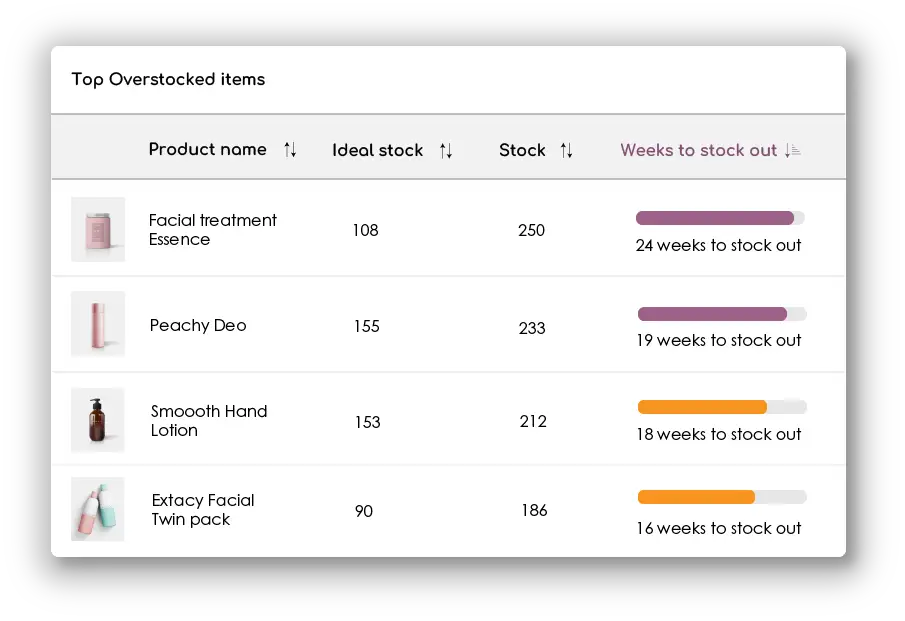

Stock Liquidation – best practices
How to free up storage space and prevent unnecessary spending or lossesThis article is all about leveraging automated inventory management to reduce overstock situations that can hurt margins and your bottom line.
Excess inventory might seem like a totally acceptable problem to have, but it’s a problem nonetheless, and come tax season, you’ll wish you’d gotten rid of it sooner.
Nobody wants to end the fiscal year with unsold inventory collecting dust in a warehouse, paying storage costs and taxes on products they aren’t selling.
Unfortunately, you can’t predict the future, aka market trends or shifts in consumer behaviour, so excess inventory is quite a common problem for businesses.
If you’re in a similar situation, you might want to look into stock liquidation. Luckily, we’re here to give you the rundown.
Table of Contents
What is excess stock?
Excess stock consists of unsold or obsolete inventory that you might have at the end of the year, or at the end of a season.
It can be the result of overstocking, inventory management errors, unpredictable shifts in market trends or consumer behaviour, or, of course, unprecedented events like global pandemics.
It’s basically extra inventory that’s sitting around gathering dust in a warehouse. In some cases, this inventory can still be sold off or donated, but perishable goods with a shelf life or an expiration date might become obsolete, in which case they’ll need to be discarded.
Why liquidation is important
The benefits of inventory liquidation are many, from freeing up capital to freeing up storage space, to building customer loyalty, and more.
Below are some of the top benefits of liquidating inventory:
Reduce holding costs
The first priority of inventory liquidation is to reduce holding costs and make sure you’re not keeping products in stock that aren’t going to sell anytime soon. You don’t want financial resources tied up in insurance and storage costs or hold on to depreciating assets.
Free up storage space
One of the main goals of inventory liquidation is freeing up valuable storage space, so you can stock up on core products that actually sell. You only have a limited amount of space in a warehouse, space that you’re paying rent for, so you want to make the best use of it.

Improve your cash flow
Getting rid of excess inventory enables businesses to turn obsolete or unsold goods into cash, improving cash flow and the overall bottom line. This cash can then be reinvested into different areas of the business.
Reduce cannibalisation
Through inventory liquidation, you can shift focus to your best-selling products and invest in promoting and marketing those products as effectively as possible.
Part of that shift is eliminating slow-moving inventory and redirecting resources toward your core products.
Tax benefits
Through inventory liquidation, you can shift focus to your best-selling products and invest in promoting and marketing those products as effectively as possible.
Part of that shift is eliminating slow-moving inventory and redirecting resources toward your core products.
When to liquidate stock...
A common question we get from our customers is — when is it the right time to liquidate inventory?
The timing of inventory liquidation will depend on several factors, including your storage capacity, products nearing their expiration date, seasonal factors, changes in market trends, the approaching tax season, and, of course, financial constraints.
A study by McKinsey showed that in the US alone, retailers sat on a whopping 740 $ billion (!) of unsold inventory in 2023.
Inventory management is crucial in all of the above-mentioned situations. Keeping tabs on your inventory and your supply chain in real time can help you predict certain shifts in consumer behavior and identify slow-moving inventory before it’s too late.
Using an inventory management platform such as Shelf Planner can help you prevent certain negative situations and take action to liquidate excess inventory before it starts hurting your bottom line.
How to liquidate stock
Now that we’ve established how excess inventory works, why you should avoid it, and what the benefits are, it’s time to get down to the business of actually liquidating your inventory.
There are several ways to accomplish this, and your choice of action will depend on the particularities of your situation, your business goals, your inventory levels, storage capacity, and a lot more. The important thing is to know that even when it seems like there’s nothing you can do about the obsolete products lying around in your warehouse, you still have options. Let’s go over them now.
1. Assess your stock
It’s sound like an open door, but the first step of the inventory liquidation process is assessment.
Before you can even begin to think about the best way to get rid of unwanted inventory, you need to get a clear picture of what you’re actually dealing with.
Take some time to run a thorough inventory audit to pinpoint obsolete, slow-moving, and unsold products, and determine whether they’re suitable for liquidation. Assess their condition, expiration dates, market demand, and any other factors relevant to your business, to identify which items in your inventory need to be liquidated.
2. Set clear goals
Your stock assessment will give you a clear idea about which products you need to focus on and which ones belong ‘in the trash pile,’ so to speak.
Before you start getting rid of them, take time to figure out your goals.
What’s the purpose of the liquidation strategy? Are you looking to free up space, reduce costs, get tax benefits, or generate some quick cash to pay off debt or reinvest in core products? Once your goals are clear, you’ll be able to come up with ways of reaching them by liquidating excess inventory in your stock.
3. Kill your darlings...
When you have a clear picture of what to get rid of and when, there are several ways to consider:
- Discount Sales
- Bulk Sales
- Auctions
- Donations
One way of selling slow-moving inventory faster is to offer discounts that can help you move these products quickly and start focusing on your core products.
Sure, it will be a loss, but not a total loss, especially if the products are still viable and well within their shelf life.
One thing to keep in mind when planning to sell excess inventory at an auction, at a discount, or in bulk on digital marketplaces is to price your items appropriately.
You don’t want to price these items too high and prevent them from selling, but you also need to look after your bottom line and make sure you’re not at a total loss. After the inventory liquidation process is over, take time to evaluate the results against your initial objectives and pinpoint areas for improvement in the future.
Avoid excess stock with Shelf Planner
The Dutch philosopher Erasmus said it best already 500 years ago: ‘to prevent is better than to cure…’
And we couldn’t agree more – the best way to prevent accumulating excess stock or ending up with unsold items at the end of the fiscal year is to focus on inventory management to nip these problems in the bud.
With Shelf Planner, you can keep tabs on your best-sellers, identify slow-moving inventory, and maintain a healthy balance between demand and supply. It also offers an inventory planning and forecasting feature, so you can avoid excess inventory piling up in the first place.
Ready to start optimising your inventory? Get in touch with our team and get a demo to see Shelf Planner in action!
Automated inventory management with Shelf Planner
Shelf Planner’s AI-based inventory management platform supports you with all the tools you need to optimise your business and can help you to reduce overstock situations.





